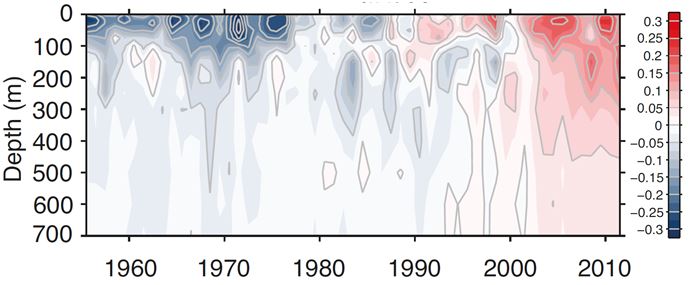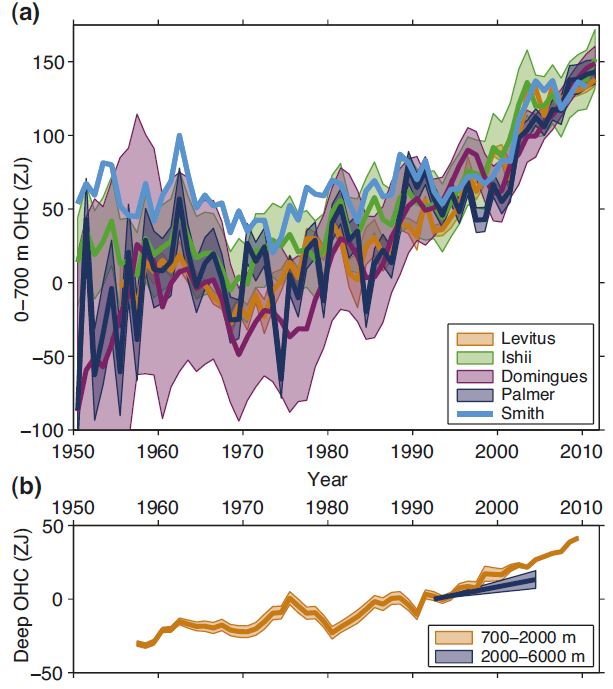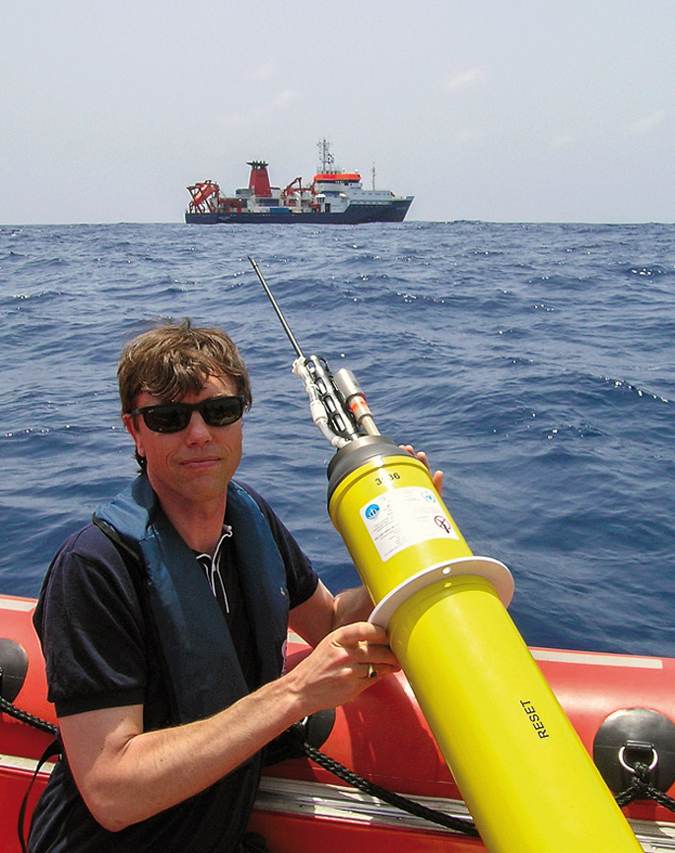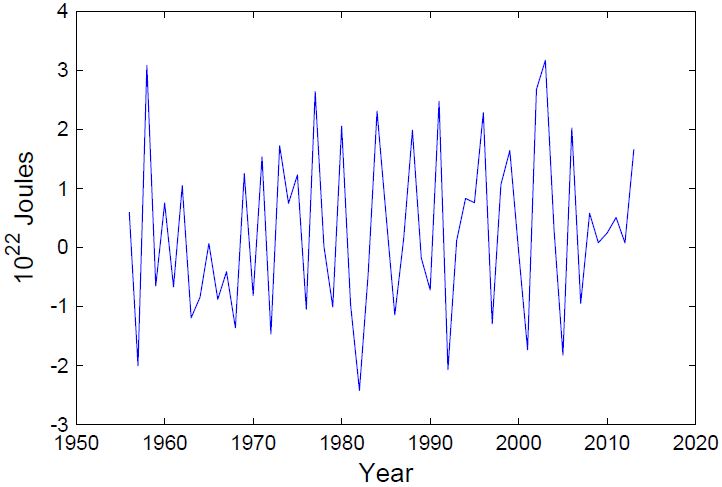The New York Times, 12 December 2027: After 12 years of debate and negotiation, kicked off in Paris in 2015, world leaders have finally agreed to ditch the goal of limiting global warming to below 2 °C. Instead, they have agreed to the new goal of limiting global ocean heat content to 1024 Joules. The decision was widely welcomed by the science and policy communities as a great step forward. “In the past, the 2 °C goal has allowed some governments to pretend that they are taking serious action to mitigate global warming, when in reality they have achieved almost nothing. I’m sure that this can’t happen again with the new 1024 Joules goal”, said David Victor, a professor of international relations who originally proposed this change back in 2014. And an unnamed senior EU negotiator commented: “Perhaps I shouldn’t say this, but some heads of state had trouble understanding the implications of the 2 °C target; sometimes they even accidentally talked of limiting global warming to 2%. I’m glad that we now have those 1024 Joules which are much easier to grasp for policy makers and the public.”
This fictitious newspaper item is of course absurd and will never become reality, because ocean heat content is unsuited as a climate policy target. Here are three main reasons why.
1. Ocean heat content is extremely unresponsive to policy.
While the increase in global temperature could indeed be stopped within decades by reducing emissions, ocean heat content will continue to increase for at least a thousand years after we have reached zero emissions. Ocean heat content is one of the most inert components of the climate system, second only to the huge ice sheets on Greenland and Antarctica (hopefully at least – if the latter are not more unstable than we think).
Figure 1. Ocean heat content in the surface layer (top panel, various data sets) and the mid-depth (700-2000 m) and deep ocean (bottom panel), from the IPCC AR5 (Fig. 3.2 – see caption there for details). Note that uncertainties are larger than for global mean temperature, the data don’t go as far back (1850 for global mean temperature) and data from the deep ocean are particularly sparse, so that only a trend line is shown.
2. Ocean heat content has no direct relation to any impacts.
Ocean heat content has increased by about 2.5 X 1023 Joules since 1970 (IPCC AR5). What would be the impact of that? The answer is: it depends. If this heat were evenly distributed over the entire global ocean, water temperatures would have warmed on average by less than 0.05 °C (global ocean mass 1.4 × 1021 kg, heat capacity 4 J/gK). This tiny warming would have essentially zero impact. The only reason why ocean heat uptake does have an impact is the fact that it is highly concentrated at the surface, where the warming is therefore noticeable (see Fig. 1). Thus in terms of impacts the problem is surface warming – which is described much better by actually measuring surface temperatures rather than total ocean heat content. Surface warming has no simple relation to total heat uptake because that link is affected by ocean circulation and mixing changes. (By the way, neither has sea-level rise due to thermal expansion, because the thermal expansion coefficient is several times larger for warm surface waters than for the cold deep waters – again it is warming in the surface layers that counts, while the total ocean heat content tells us little about the amount of sea-level rise.)

Figure 2. Temperature anomaly in °C as a function of ocean depth and time since 1955. (Source: Fig. 3.1 of the IPCC AR5.)
3. Ocean heat content is difficult to measure.
The reason is that you have to measure tiny temperature changes over a huge volume, rather than much larger changes just over a surface. Ocean heat content estimates have gone through a number of revisions, instrument calibration issues etc. If we were systematically off by just 0.05 °C throughout the oceans due to some instrument drift, the error would larger than the entire ocean heat uptake since 1970. If the surface measurements were off by 0.05 °C, this would be a negligible correction compared to the 0.7 °C surface warming observed since 1950.
Two basic ocean physics facts
Let us compare the ocean to a pot of water on the stove in order to understand (i) that heat content is an integral quantity and (ii) the response time of the ocean.
Imagine you’ve recently turned on the stove. The heat content of the water in the pot will increase over time with a constant setting of the stove (note that zero emissions correspond to a constant setting – emitting more greenhouse gases turns up the heat). How much heat is in the water thus depends mainly on the past history (how long the stove has been on) rather than its current setting (i.e. on whether you’ve recently turned the element up a bit). That is why it is an integral quantity – it integrates the heating rate over time. You can tell from the units: heat content is measured in Joules, heating rate in Watts which is Joules per second, i.e. per unit of time.
The water in the pot heats up much faster than the global ocean. The water in the pot may be typically ~10 cm deep and heated at a rate of 1500 Watt or so from below. But the ocean is on average 3700 meters deep (thus has a huge heat capacity) and is heated at a low power input of the order of ~1 Watt per square meter of surface area. Also it is heated from above and not well mixed but highly stratified. Warm water floats on top, which hinders the penetration of heat into the ocean. Water in parts of the deep ocean has been there for more than a millennium since last exposed to the surface. Therefore it will take the ocean thousands of years to fully catch up with the surface warming we have already caused. That is why limiting ocean heat content to 1024 Joules is not possible even if we stop global warming right now – even though this amount is four times the amount of heating already caused since 1970. Ocean heat content simply does not respond on policy-relevant time scales.
If you turn your setting on the stove higher or lower, what you immediately change is the rate of heating – the wattage. So would limiting the rate of ocean heat uptake be a suitable policy target? At least it would be responsive to policy at a relevant time scale, like surface temperature. But here reasons two and three come into play. The rate of heat uptake has even less connection to any impacts than the heat content itself. And the time series of this rate is extremely noisy.
Charles Saxon in the New Yorker on the impacts of deep ocean heat content on society.
So why do Victor and Kennel propose to use deep ocean heat content as policy target?
In a recent interview, David Victor has explained why he wants to “ditch the 2 °C warming goal”, as the title of his Nature commentary with Charles Kennel reads:
There are some other indicators that look much more promising. One of them is ocean heat content.
The reason that Victor and Kennel gave for preferring ocean heat content over a global mean surface temperature target is this:
Because energy stored in the deep oceans will be released over decades or centuries, ocean heat content is a good proxy for the long-term risk to future generations and planetary-scale ecology.
I criticized this because the deep ocean will not release any heat in the next thousand years but rather continue to absorb heat. In his response at Dot Earth, Victor replied that I had “plucked this sentence out of context”. However, in their article there simply is no context that would explain how “energy stored in the deep oceans will be released over decades or centuries” or how this would make it “a good proxy for the long-term risk”. This statement is plainly wrong, and Victor would have been more credible to simply admit that. Victor there further argues that “the data suggest [OHC] is a more responsive measure” than surface temperature, but what he means by that, given the huge thermal inertia of the oceans, beats me.
My impression is this. Victor and Kennel appear to have been taken in by the rather overblown debate on the so-called ‘hiatus’, not realizing that this is just about minor short-term variability in surface temperature and has no bearing on the 2 °C limit whatsoever. In this context they may have read the argument that ocean heat content continues to increase despite the ‘hiatus’ – which is a valid argument to show that there still is a radiative disequilibrium and the planet is still soaking up heat. But it does not make ocean heat content a good policy target. The lack of response to short-term wiggles like the so-called ‘hiatus’ points at the fact that ocean heat content is very inert, which is also what makes it unresponsive to climate policy and hence a bad policy target. So my impression is that they have not thought this through.
I agree with the criteria that a metric for a policy goal needs to be (a) related to impacts we care about (otherwise why would you want to limit it) and (b) something that can be influenced by policy. A more technical third requirement is that it must be something we can measure well enough, with well-established data sets going far enough back in time to understand baseline variability.
But it seems clear to me that global mean surface temperature is the one metric that best meets these requirements. It is the one climate variable most clearly linked to radiative forcing, through the planetary energy budget equation. The nearly linear relation of cumulative emissions and global temperature allows one to read the remaining CO2 emissions budget off a graph (Fig. SPM.10 of the AR5 Summary for Policy Makers) once the global temperature target is agreed. Most impacts scale with global temperature, and how a whole variety of climate risks – from declining harvests to the risk of crossing the threshold for irreversible Greenland ice sheet loss – depends on temperature has been thoroughy investigated over the past decades. And finally we have four data sets of global temperature in close agreement (up to ~0.1 °C), natural variability on the relevant time scales is small (also ~0.1 °C) compared to the 2 °C limit, and models reproduce the global temperature evolution over the past 150 years quite well when driven by the known forcings.
I find the arguments made by Victor and Kennel highly self-contradictory. They find global mean temperature too variable to use as a policy target (that is the thrust of their “hiatus” argument) – but they propose much more noisy indicators like an index of extreme events. They think global surface temperature is affected by “all kinds of factors” – and propose ocean heat content, which is determined by the history of surface temperature. Or the surface area in which conditions stray by three standard deviations from the local and seasonal mean temperature, which is a straight function of global surface temperature with some noise added. They argue surface temperature is something which can’t directly be influenced by policy – and propose deep ocean heat content where this is a hundred times worse. They say limiting warming to 2 °C is “effectively unachievable” – and then say “it’s not going to be enough to stop warming at 2 degrees“. I simply cannot see a logically coherent argument in all this.
My long-time friend and colleague Martin Visbeck launching an Argo float in the Pacific.
The bottom line
Should we monitor heat storage in the global ocean? By all means, yes! The observational oceanography community has long been making heroic efforts in this difficult area, not least by getting the Argo system off the ground (or rather into the water). That is no small achievement, which has revolutionized observational physical oceanography for the upper 2,000 meters of the world ocean. Currently Deep Argo is under development to cover depths up to 6,000 meters (see e.g. News&Views piece by Johnson and Lyman just published in Nature). These efforts need and deserve secure long-term funding.
Is ocean heat storage a good target for climate policy, to replace the 2 °C limit? Certainly not! I’ve outlined the reasons above.
[p.s. I am grateful that David Victor has apologized to me for comparing it to “methods of the far right” that I introduced him as a “political scientist” in my previous post (as in fact he is in the intro to his interview). This matter is now settled and forgotten, with no hard feelings.]
Update 21 October: I thank David Victor and Charles Kennel for responding to this article below. Answering this again would turn the discussion in circles – I’ve made my points and I think our readers now have a good basis to form their own opinion. Just one piece of additional data that might be informative, since Victor and Kennel below suggest to use the rate of heat content change for a well-measured portion of the ocean, rather than absolute heat content. Below I plotted the annual heat uptake of the upper 700 meters. (I already made this plot last week, it is the basis of me saying above that this measure is very noisy – the data can be downloaded from NOAA.)




James, Eli is still waiting for Roger Pielke Sr.’s response. It seems that he wants others to answer his questions but is quite shy about answering the questions of others, even simple questions.
http://www.climatesciencewatch.org/2014/10/08/the-case-for-the-2-c-warming-limit/
Interested observer question here again. Earlier in the thread you see some assertions along the lines that “oceans are opaque to longwave”, i.e. the frequent claim that downwelling IR only penetrates a couple of microns into the ocean at the warmest layer and so is unable to heat the deeper ocean. You see this all over the internet as an argument against global warming (can’t actually be a reason the oceans are accumulating heat). But in the discussion here it seems implicit that everyone accepts global warming does indeed land in the ocean. I’d like to make sure I’m clear on the mainstream physics view on the mechanism here.
This series on scienceofdoom explores some models explaining why downwelling IR actually can warm the ocean (less cooling at that surface layer leads to more heat accumulation from solar in the ocean). It makes sense to me, but I just thought I’d double-check whether this is consistent with the mainstream view.
http://scienceofdoom.com/2010/10/06/does-back-radiation-heat-the-ocean-part-one/
Anyone? Thanks as always for explanations.
waxliberty,
Science of Doom is typically very good and I went through some of that post you highlight a while ago and couldn’t see anything to criticise. Others may be able to explain this better than I can, but the “longwavelength doesn’t penetrate very deeply, therefore can’t heat the deep ocean” is a bit of a strawman. Anthropogenic global warming (AGW) is really an energy balance issue. If we are receiving more energy than we lose, we will warm until the surface temperatures rise to the point where the outgoing energy balances the incoming energy. Since the oceans have such a large heat capacity compared to any other component of the climate system, they will accrue most of the excess energy. This energy doesn’t have to be transported via radiation, though. It can be transported via conduction (transfer of energy via molecular motion) or advection (the bulk flow of material within the medium – currents).
153-4: It’s worth going on to read Part Two of that, as well:
http://scienceofdoom.com/2010/10/23/does-back-radiation-heat-the-ocean-part-two/